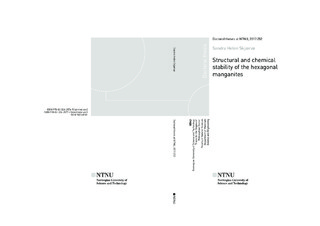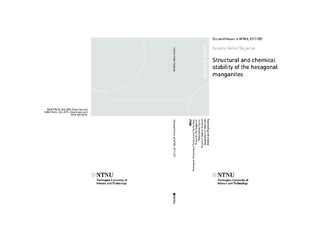| dc.contributor.advisor | Selbach, Sverre Magnus | |
| dc.contributor.advisor | Tybell, Thomas | |
| dc.contributor.author | Skjærvø, Sandra Helen | |
| dc.date.accessioned | 2017-09-18T09:14:03Z | |
| dc.date.available | 2017-09-18T09:14:03Z | |
| dc.date.issued | 2017 | |
| dc.identifier.isbn | 978-82-326-2577-2 | |
| dc.identifier.issn | 1503-8181 | |
| dc.identifier.uri | http://hdl.handle.net/11250/2455052 | |
| dc.description.abstract | The link between atomic interactions and functional properties in the fascinating material system called hexagonal manganites is investigated in this thesis. By using both neutron scattering measurements and first principles calculations, the structural flexibility determining the formation of ferroelectric polarization upon cooling is revealed. The thesis continues with presenting how, and where, atomic scale flaws in the crystal structure form; going on to connect it to the structural flexibility.
The structural changes that occur across the ferroelectric transition upon cooling have been debated for decades. The controversy has been about why the observable polarization is not seen until several hundred degrees below the transition temperature, where the key structural changes, called trimerization, occur. This thesis explains that strong chemical bonds between the yttrium and oxygen atoms force the structure into trimerization at all temperatures, but that this trimerization is rotationally flexible until several hundred degrees below the transition temperaure. When the flexibility of the trimerization vanishes, an observable ferroelectric polarization can be observed.
The trimerization flexibility also explains where both deficiency and excess of oxygen at various sites in the structure form. For the first time, the additional oxygen atoms are shown to be a possible source for the observed electrical conductivity in these materials. The results thus hold great potential for creating and tuning nano-electronic functionalities.
The thesis explains aspects of the structural and chemical stability – and the link between the two – of the hexagonal manganites, and provides important keys for tuning these materials for potential use in nano-sized electrochemical applications. | nb_NO |
| dc.language.iso | eng | nb_NO |
| dc.publisher | NTNU | nb_NO |
| dc.relation.ispartofseries | Doctoral theses at NTNU;2017:252 | |
| dc.relation.haspart | Paper 1: Skjærvø, Sandra Helen; Tjønneland Wefring, Espen; Nesdal, Silje K.; Gaukås, Nikolai Helth; Olsen, Gerhard Henning; Glaum, Julia; Tybell, Per Thomas Martin; Selbach, Sverre Magnus. Interstitial oxygen as a source of p-type conductivity in hexagonal manganites. Nature Communications 2016 ;Volum 7.
http://dx.doi.org/10.1038/ncomms13745
This work is licensed under a Creative Commons Attribution 4.0 International License | nb_NO |
| dc.relation.haspart | Paper 2: Unconventional order-disorder phase transition in improper ferroelectric hexagonal manganites | nb_NO |
| dc.relation.haspart | Paper 3: Oxygen vacancy ordering and the interplay with neutral domain walls in h-YMnO3 -
Is not included due to copyright | nb_NO |
| dc.title | Structural and chemical stability of the hexagonal manganites | nb_NO |
| dc.type | Doctoral thesis | nb_NO |
| dc.subject.nsi | VDP::Technology: 500::Materials science and engineering: 520 | nb_NO |

